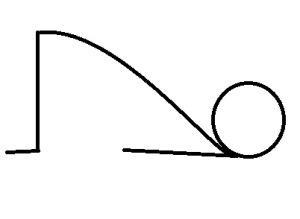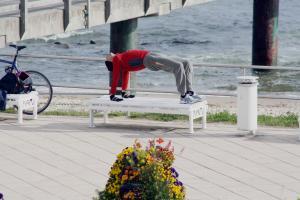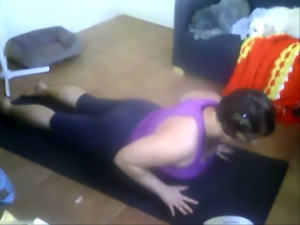Continued from here.
I have spent some time looking for yoga asanas in which neck flexion is a prominent component. Among common poses, there are some:
- Bridge Pose
- Supported Shoulderstand
- Plow Pose
- Cat Pose
In three out of four of these poses, the neck itself is resting on the ground. In the last — cat pose — the act of dropping the crown of the head is aided by gravity. In none of these four — and probably in fairly few overall — are the deep neck flexor muscles actually working. Which may relate a little back to this idea about those neck flexors often being elongated and weak (though that plays out in far more complicated ways than yoga, I’m sure).

However, when it comes to yoga, there are some fairly common postures where the neck flexors are working — not in flexion but rather in extension of the cervical spine. Take a look at:
- Cobra Pose
- Upward Facing Dog
- Reverse Table
- Upward Plank
- Camel Pose
All of these include circumstances where gravity acting on the skull is dropping the neck backward into extension. This is generally desirable as it’s in the dynamics of each pose — given that each is, to varying degrees, a back bend. What’s not generally desirable is for gravity to pull the head and neck back unchecked, as this can become unfun for the cervical vertebra, either acutely or over time. Basically, it’s good if one can avoid crunching the discs and nerves along the spine — and the neck is part of that spine.
This, then, is where the flexor muscles come into play. They’re actually working eccentrically (while they’re lengthening) in order to control the amount of extension, as well as to be able to pick the head back up again afterward.
At least, this is what should be happening — with some exceptions — in these types of asana.

By AlterWolf49 (Own work) [CC-BY-SA-3.0 (http://creativecommons.org/licenses/by-sa/3.0)%5D, via Wikimedia Commons
(The exception is that for some people entering camel, reverse table, and upward plank, the trapezius muscle can form a sort of shelf at the juncture of the base of the neck and the upper back, and the reclining neck can sort of rest on that. I definitely have that experience in camel — and in it, pretty much none of my neck muscles are working at all. It’s completely relaxed front and back. Even then, the neck flexors still need to bring the neck back to neutral to safely exit the pose.)
However, what sometimes does happen — as in, what I’ve occasionally experienced and what I’ve often seen or heard cautioned against — is that yogis either let their necks go into freefall, or they actively crank their necks further into extension than the neck comfortably wants to go. I’ve done that — sometimes unintentionally, sometimes on purpose, with the idea that it meant I was going “deeper” into the pose. Fun fact: The cervical spine works much more independently than do the thoracic and lumbar spines — so the neck can arch or fall backward without generating any kind of deeper overall back bend.
I was lucky enough not to cause myself anything but maybe fairly minor injury while doing that. I mean, it was harder for me to feel at ease in those poses — and I might have caused myself some short-lived back-of-neck tension (and certainly wasn’t doing anything to relieve it) — but even that cause of tension is hypothetical rather than concretely known. Even allowing this, though, allowing — or requiring — my neck to crunch back into too much extension was still hindering my experience in these poses.
If I started to feel too much neck strain — likely, as a result of dropping my neck too far back — I stopped the rest of my spine from progressing in the back bend, which is actually not great since the rest of my spine is much more where back bends are targeting in the first place. As a result, I probably didn’t experience optimal opening and strengthening in the portions of my body that back bends are most intended to benefit.

Additionally, I can’t help but feel that concerns surrounding this are often related to preoccupations with what poses should look like rather than what they should feel like. I mean, I know it happens in part due to ease of explanation, but the overwhelming majority of pose descriptions I’ve seen focus on the aesthetics of a posture rather than the experience of it. Even the ones who do include sensation tend to include it as an addition, if not a side note or an afterthought. Very few pose guides approach the asana from the perspective of what it should feel like to enter or be in a pose?
So what does it feel like to experience controlled neck extension in one of these back bends?
I have no idea if these work for everyone, but some visualizations that have helped me —
In cobra and up dog, controlled extension feels like I’m leading with the crown of my head rather than with the atlanto-occipital joint at the base of my skull. So my head is still moving backward in space — my neck, like the rest of my spine, is in extension — but it’s proportional to the arc that my whole spine is creating.
Because of the different positioning — and therefore different relationship to gravity — in reverse table and upward plank, I feel like I’m actively flexing my neck — that is, drawing my chin toward my chest — a lot more in order to keep my neck from falling back completely. In these two postures, I am not a person whose trapezius makes a comfortable resting shelf, and so my preference is to keep my neck in line with the rest of my spine.
In camel, however, I do get that shelf, so engaging neck flexion here is something I really only think about when it comes time to get out of the pose. It happens in conjunction with engaging my quads and my abdominals (or, rather, engaging these muscles more since they don’t actually relax when I’m in the posture) to bring up the rest of me.
Hrm. With all that talk of how the neck flexors work when the neck is extending backward, maybe it’s time — next time — to figure out what the neck extensors actually are.

